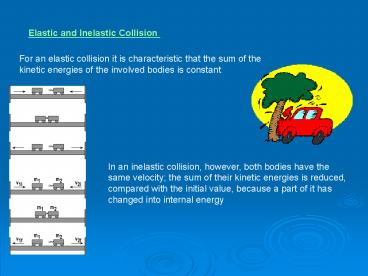Elastic and Inelastic Collision - PowerPoint PPT Presentation
1 / 22
Title:
Elastic and Inelastic Collision
Description:
Inelastic collisions occur when the colliding bodies ... This may be generalized to say that for a head-on elastic collision of equal masses, ... The Air Track http ... – PowerPoint PPT presentation
Number of Views:972
Avg rating:3.0/5.0
Title: Elastic and Inelastic Collision
1
Elastic and Inelastic Collision
For an elastic collision it is characteristic
that the sum of the kinetic energies of the
involved bodies is constant
In an inelastic collision, however, both bodies
have the same velocity the sum of their kinetic
energies is reduced, compared with the initial
value, because a part of it has changed into
internal energy
2
Inelastic collisions occur when the colliding
bodies deform or stick together
An inelastic collision is one where the total
kinetic energy of the colliding particles is not
the same after the collision as it was before
Have you ever smashed a toy car into a wall?
Before the collision, the car was moving fast and
had lots of kinetic energy - and afterward, it
just sat there with zero kinetic energy
3
Energy and momentum are conserved in elastic
collisions. In the game of billiards, elastic
collisions occur between balls of equal mass.
However, elastic collisions can occur between
objects of very different mass. This difference
in mass creates different outcomes for the
collisions
Have you ever seen a basketball bounce off a
backboard? It comes back with the same level of
kinetic energy as it had when it hit, which means
it was an elastic collision.
4
(No Transcript)
5
The total momentum of the involved bodies is
conserved, regardless whether the collision is
elastic or inelastic
Momentum is conserved in inelastic collisions,
but one cannot track the kinetic energy through
the collision since some of it is converted to
other forms of energy.
6
Collisions in ideal gases approach perfectly
elastic collisions, as do scattering interactions
of sub-atomic particles which are deflected by
the electromagnetic force. Some large-scale
interactions like the slingshot type
gravitational interactions between satellites and
planets are perfectly elastic.
7
(No Transcript)
8
Head-on Elastic Collisions
For a head-on collision with a stationary object
of equal mass, the projectile will come to rest
and the target will move off with equal velocity,
like a head-on shot with the cue ball on a pool
table. This may be generalized to say that for a
head-on elastic collision of equal masses, the
velocities will always exchange.
9
In a head-on elastic collision where the
projectile is much more massive than the target,
the velocity of the target particle after the
collision will be about twice that of the
projectile and the projectile velocity will be
essentially unchanged.
10
For a non-head-on elastic collision between equal
masses, the angle between the velocities after
the collision will always be 90 degrees. The spot
on a pool table is placed so that a collision
with a ball on the spot which sends it to a
corner pocket will send the cue ball to the other
corner pocket.
11
For non-head-on collisions, the angle between
projectile and target is always less than 90
degrees. This was important in the analysis of
the original Rutherford scattering experiment.
12
This case implies that a train moving at 60
miles/hr which hits a small rock on the track
could send that rock forward at 120 miles/hr if
the collision were head-on and perfectly elastic.
It also implies that if the speed of the head of
your golf club is 110 miles/hr, the limiting
speed on the golf ball off the tee is 220
miles/hr in the ideal case. That is, the limiting
speed of the ball depends strictly on the
clubhead speed, and not on how much muscle power
you put into the swing.
13
In a head-on elastic collision between a small
projectile and a much more massive target, the
projectile will bounce back with essentially the
same speed and the massive target will be given a
very small velocity. One example is a ball
bouncing back from the Earth when we throw it
down.
In the case of a non-head on elastic collision,
the angle of the projectiles path after the
collision will be more than 90 degrees away from
the targets motion.
14
Inelastic Collision Examples
Most ordinary collisions are classified as
inelastic collisions because some of their
kinetic energy is converted to other forms such
as internal energy. Links to some examples are
provided.
15
Example of Force on Car
16
Inelastic Collisions Perfectly elastic collisions
are those in which no kinetic energy is lost in
the collision. Macroscopic collisions are
generally inelastic and do not conserve kinetic
energy, though of course the total energy is
conserved. The extreme inelastic collision is one
in which the colliding objects stick together
after the collision, and this case may be
analyzed in general terms
17
K.E. Lost in Inelastic Collision
18
Non-Stretching Seatbelt
Stretching Seatbelt
19
Airplane and Duck
20
Ballistic Pendulum
The ballistic pendulum is a classic example of a
dissipative collision in which conservation of
momentum can be used for analysis, but
conservation of energy during the collision
cannot be invoked because the energy goes into
inaccessible forms such as internal energy. After
the collision, conservation of energy can be used
in the swing of the combined masses upward, since
the gravitational potential energy is
conservative.
21
The Air Track
22
http//www.walter-fendt.de/ph11e/collision.htm
http//hyperphysics.phy-astr.gsu.edu/hbase/colcon.
htmlc1































